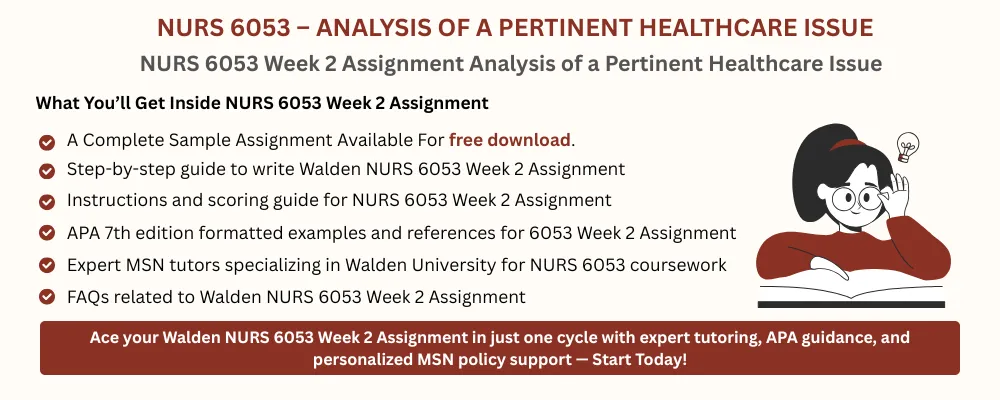NURS 6053 Week 2 Assignment FREE DOWNLOAD
NURS 6053 Week 2 Assignment Analysis of a Pertinent Healthcare Issue:
Nursing Shortages and Burnout
Student Name
Walden University
NURS6053
Professor Name
Date
Analysis of a Pertinent Healthcare Issue: Nursing Shortages and Burnout
Nursing shortages and subsequent increase in burnout among healthcare workers are increasingly pressuring healthcare organizations across the United States. These problems present operational and clinical challenges in hospital settings with high patient acuity and in which there is a demand to provide continuous care at all times. The role of leadership in managing this stressor is essential because the sustainability of the workforce in the long run is directly associated with patient outcomes, expenses incurred by the organization, and trust that the community has in medical services. Nursing shortages can be considered one of the most prominent national healthcare stressors that affect the quality of care and the sustainability of the workforce (Tamata & Mohammadnezhad, 2022).
Impact of Nursing Shortages and Burnout in Hospital Settings
Shortages in the hospital context have been associated with increased nurse-to-patient ratios, overtime, and increasing temporary agency workers. In recent years, the turnover rate of the medical-surgical unit in our hospital has been 19%, which is quite high compared to the 15% national rate. High workload, emotional exhaustion, and work-life imbalance are always mentioned as significant causes of leaving the job in exit interviews. Patient satisfaction scores, particularly in responsiveness of staff and the overall care experience, also fall by 12 percent. The economic nightmare is nurse turnover, which costs an average hospital 40,000$ to 64,000$ in recruiting and training nurses and the lost productivity (Weston, 2024). In addition to money, there is the human cost. Burnout is emotional exhaustion, depersonalization, and decreased accomplishment. Burned-out nurses have an increased chance of committing clinical errors, retiring to work alone, and abandoning the profession altogether, further exacerbating the shortage. Nursing workforce instability is a vicious cycle that leads to a shortage of staff, increased workload on the staff, and burnout.
Insights from Literature
The article was a study of global retention of nurses (Farahani et al., 2024). The review has found seven broad categories affecting retention, and they are personal, interpersonal, organizational, emotional, educational, reward, and leadership factors. Results show that positive leadership, appreciation, and career growth were foreseeable variables that contributed to nurse retention. The article notes that the organizations that fail to consider these factors suffer greater workforce attrition, and the organizations that implement comprehensive retention strategies are more stable.
Martin et al. (2023) have summarized the National Nursing Workforce Survey of 2022. The researchers found that more than 60 percent of nurses reported that their workload had increased, and almost half of them reported that they suffered burnout. The less experienced personnel and critical care nurses were hit relatively hard. Interestingly, the study also noted a 3.3 percent reduction in the U.S. nursing workforce during the pandemic, which also contributes to the importance of stressors in transforming them into measurable workforce losses. Large-scale surveys have shown evidence that burnout is not a health issue on an individual level only, but also a risk factor related to the overall healthcare delivery.
Strategies Used in Other Organizations
The systematic review recommended a number of strategies that organizations worldwide have implemented, such as leadership-based recognition programs, monetary rewards, flexible work hours, and greater access to continuing education. These interventions were planned to improve job satisfaction and professional development and to decrease stress. In the same way, a survey-based study in the U.S. suggested workforce modeling to increase or decrease staffing ratios, wellness programs, and changes of policies at the organization and state levels to enhance working conditions. Businesses that have successfully managed resilience training, mental health services, and flexible work schedules have had lower turnover and increased morale. However, there are disadvantages to strategies as well. An example of this is the use of financial incentives to reduce attrition without resolving systemic workload problems, which will only temporarily decrease attrition but will not yield long-term retention. Similarly, a wellness program that is poorly staffed can be viewed as a facade and will create suspicion amongst employees. Nursing burnout cannot be addressed effectively without multi-dimensional solutions that extend past short-term solutions.
Hospital Setting
Leadership-based solutions, such as an improved recognition system, formal mentorship, and frequent professional development, can be used as a form of reinforcement in our hospital. Flexible scheduling, including self-scheduling software, would also give nurses a sense of freedom, which should help decrease burnout. On the upside, these interventions have the potential to enhance morale, reduce turnover, and increase patient safety outcomes. On the downside, flexible scheduling can create the problem of staffing shortages on the less desirable shifts, which will have to be monitored.
In the same way, though staff satisfaction increases with professional development, it may temporarily decrease the number of available staff on the floor, which places strain on the remaining staff. Consequently, the leadership has to strike the right balance between short-term staffing and long-term workforce sustainability. There is a high likelihood that the subsequent intervention, leading to the eventual rectification of the workload issue in organizations and individual variables that predict well-being, will have a long-term effect that is sustainable with respect to alleviating and stabilizing burnout and the nursing workforce (Cohen et al., 2023).
Conclusion
Nursing burnout and shortage are a topical national healthcare stressor with far-reaching hospital implications. It has been shown that without action, the cycle of attrition and overwork will continue at the cost of patient outcomes and organizational performance. The first two are the most evident: the supporting leadership, flexible working hours, and career growth, which, per the academic literature, should be viewed in such a manner that the development of the unwanted effects would have been prevented. The issue of nursing workforce instability is critical to patient care safety and quality, and the sustainability of healthcare organizations in the future.
Instructions To Write NURS 6053 Week 2 Assignment
Need instructions for this assessment? Contact us now and get expert guidance right away!
Instructions File For 6053 Week 2 Assignment
Instruction file for this assessment will be added soon.
NURS 6053 Week 2 Assignment Rubrics
Rubrics for this assessment will be added soon.
References For NURS 6053 Week 2 Assignment
Cohen, C., Pignata, S., Bezak, E., Tie, M., & Childs, J. (2023). Workplace interventions to improve well-being and reduce burnout for nurses, physicians and allied healthcare professionals: A systematic review. British Medical Journal Open, 13(6), 1–23. https://doi.org/10.1136/bmjopen-2022-071203
Farahani, M. A., Nargesi, S., Saniee, N., Dolatshahi, Z., Heidari Beni, F., & Shariatpanahi, S. (2024). Factors affecting nurses retention during the COVID‐19 pandemic: A systematic review. Human Resources for Health, 22(1). https://doi.org/10.1186/s12960-024-00960-7
Martin, B., Kaminski-Ozturk, N., O’Hara, C., & Smiley, R. (2023). Examining the impact of the COVID-19 pandemic on burnout and stress among U.S. nurses. Journal of Nursing Regulation, 14(1), 4–12. https://doi.org/10.1016/s2155-8256(23)00063-7
Tamata, A. T., & Mohammadnezhad, M. (2022). A systematic review study on the factors affecting shortage of nursing workforce in the hospitals. Nursing Open, 10(3), 1247–1257. https://doi.org/10.1002/nop2.1434
Weston, E. (2024, November). Cost of nurse turnover in healthcare facilities. NurseRegistry. https://www.nurseregistry.com/blog/cost-of-nurse-turnover/
Best Professors To Choose From For NURS 6053 Class
- Dr. Elvira G. Phelps
- Dr. Amber Donnelli
- Dr. Phyllis J. Lawrence
- Dr. Lynn Parsons
- Dr. Bernadette Pollard
(FAQs) related to NURS 6053 Week 2 Assignment
Question 1: Where can I download a free sample for NURS 6053 Week 2 Assignment?
Answer 1: Download a free sample from Tutors Academy.
Question 2: Where can I find the rubrics and instruction file for NURS 6053 Week 2 Assignment?
Answer 2: Get the rubric and instruction file from the Tutors Academy website.
Do you need a tutor to help with this paper for you with in 24 hours.
- 0% Plagiarised
- 0% AI
- Distinguish grades guarantee
- 24 hour delivery

